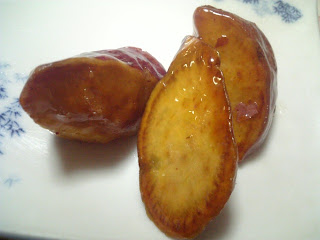



This is the osechi ryori, Japanese food for New Year's Day, that I cooked for Shinji-san and his family. Iritori is the colorful box with carrots, snow peas, lotus root, gobo, konnyaku, shiitake mushrooms and chiken.
The second from the bottom photo has the sweet items including the kuri kinton of Satsuma sweet potatoes and chestnuts, tazukuri dried sardines with a sweet soy sauce, a marshmallow-like sweet egg omelette called date maki, kamaboko and kuromame sweet black beans (made by Shinji's mom).
The third from the bottom has kohaku namasu pickled daikon, carrots and yuzu, tataki gobo with a sesame dressing, kuwai, pickled renkon lotus root, kombu wrapped around nishin, and kazunoku (made by Shinji's dad).
The picture on the top shows you the three boxes. This was packed up on the evening of the 31st and we had it for breakfast on January 1st.

 Hoshigaki is a traditional Japanese dried fruit.
Hoshigaki is a traditional Japanese dried fruit.


